Early Childhood Learning: Comparing Play and Learn with Emilia Reggio
VerifiedAdded on 2023/05/28
|8
|2238
|470
Essay
AI Summary
This essay explores early childhood learning, focusing on the "Play and Learn through the Arts" method and its connection to the multimodal approach in teaching. It defines multi-modal approaches, emphasizing the use of various sensory and cognitive tools in education, and highlights the creation of interactive learning environments. The essay then details the Play and Learn method, emphasizing its activity-oriented approach suitable for preschool children. It establishes links between this method and the multi-modal approach, highlighting the versatility and inclusivity of the approach. The essay also compares the Play and Learn method with the Emilia Reggio approach, discussing their similarities in promoting child development and pointing out differences, particularly the Emilia Reggio's focus on academic excellence and a more empirical, less multi-modal approach. References are provided to support the arguments and discussions made in the essay.
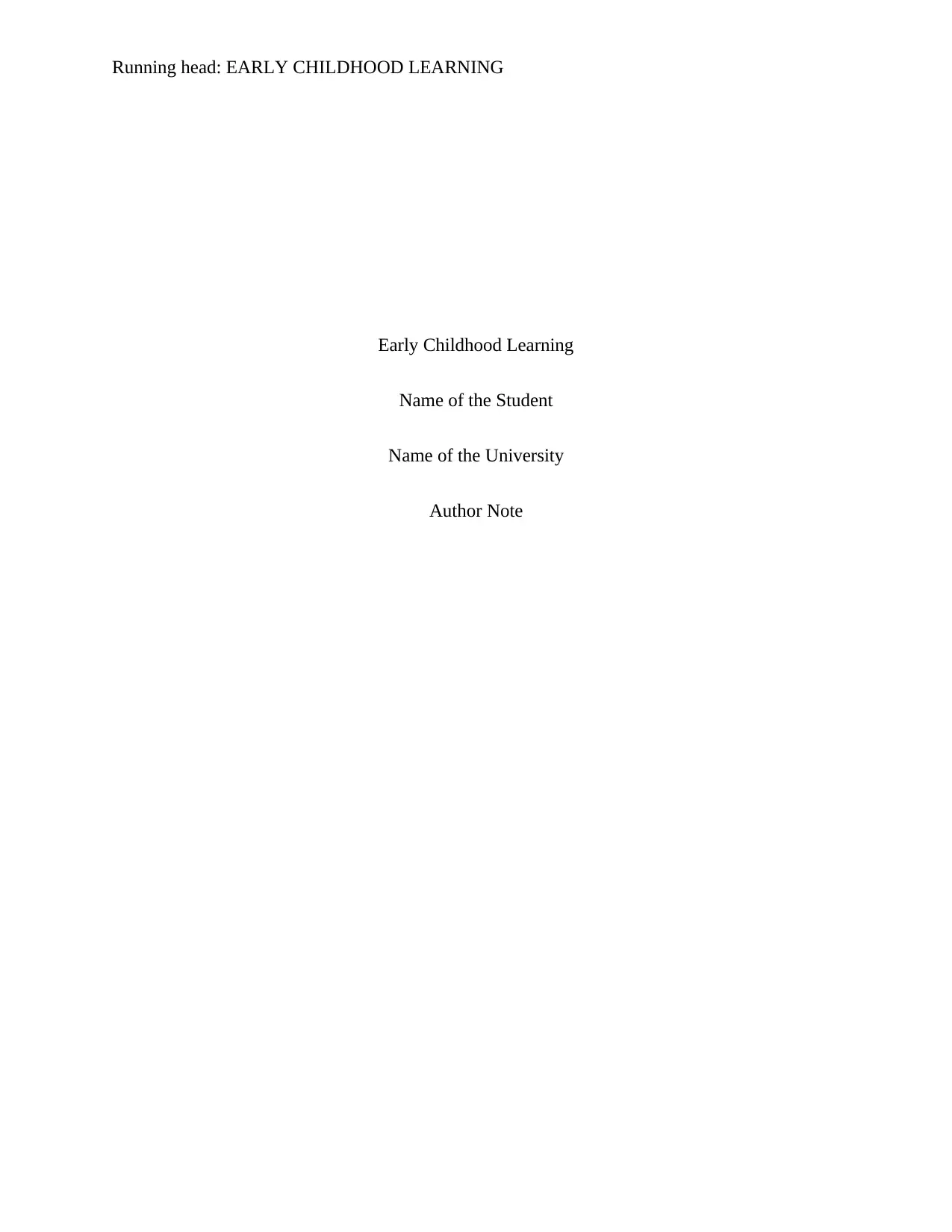
Running head: EARLY CHILDHOOD LEARNING
Early Childhood Learning
Name of the Student
Name of the University
Author Note
Early Childhood Learning
Name of the Student
Name of the University
Author Note
Paraphrase This Document
Need a fresh take? Get an instant paraphrase of this document with our AI Paraphraser
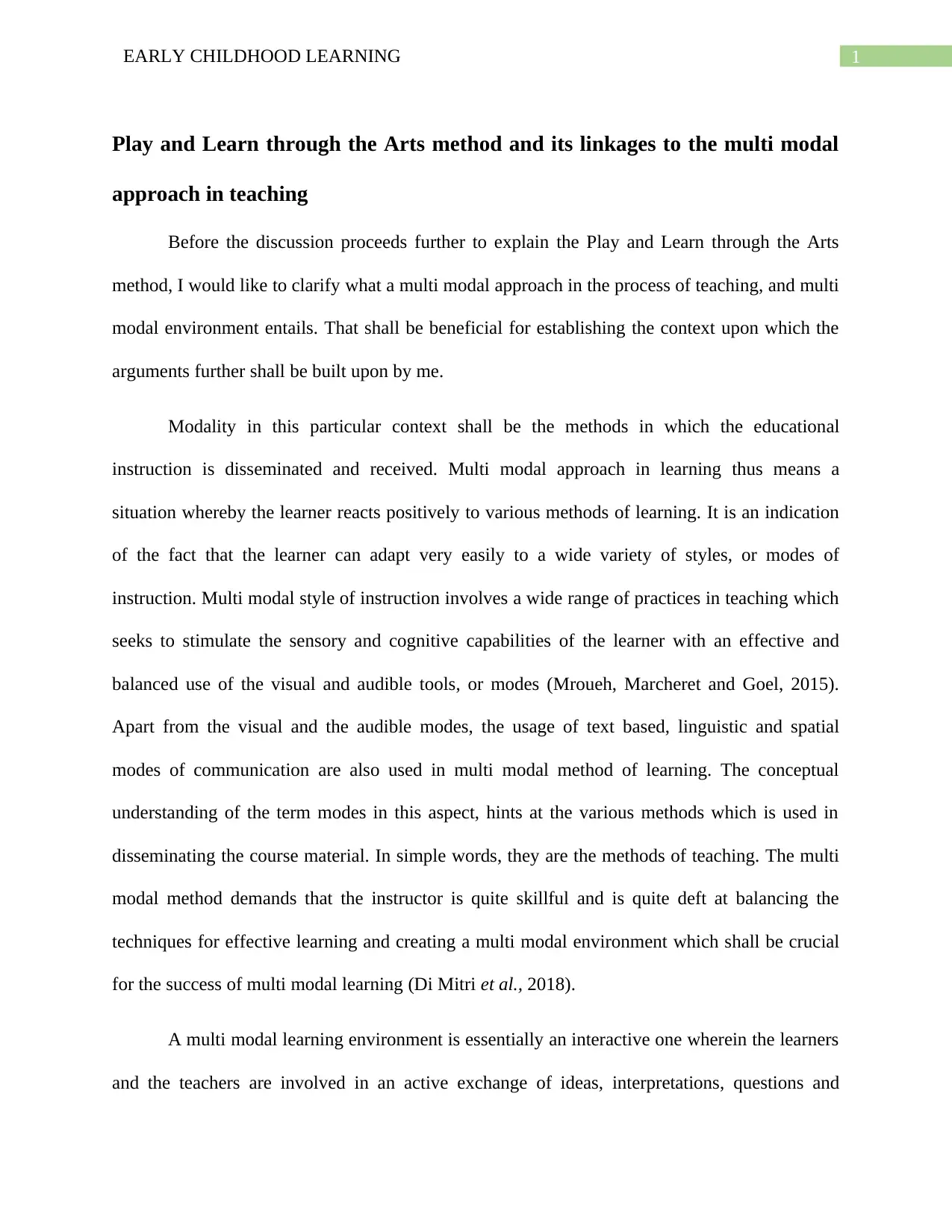
1EARLY CHILDHOOD LEARNING
Play and Learn through the Arts method and its linkages to the multi modal
approach in teaching
Before the discussion proceeds further to explain the Play and Learn through the Arts
method, I would like to clarify what a multi modal approach in the process of teaching, and multi
modal environment entails. That shall be beneficial for establishing the context upon which the
arguments further shall be built upon by me.
Modality in this particular context shall be the methods in which the educational
instruction is disseminated and received. Multi modal approach in learning thus means a
situation whereby the learner reacts positively to various methods of learning. It is an indication
of the fact that the learner can adapt very easily to a wide variety of styles, or modes of
instruction. Multi modal style of instruction involves a wide range of practices in teaching which
seeks to stimulate the sensory and cognitive capabilities of the learner with an effective and
balanced use of the visual and audible tools, or modes (Mroueh, Marcheret and Goel, 2015).
Apart from the visual and the audible modes, the usage of text based, linguistic and spatial
modes of communication are also used in multi modal method of learning. The conceptual
understanding of the term modes in this aspect, hints at the various methods which is used in
disseminating the course material. In simple words, they are the methods of teaching. The multi
modal method demands that the instructor is quite skillful and is quite deft at balancing the
techniques for effective learning and creating a multi modal environment which shall be crucial
for the success of multi modal learning (Di Mitri et al., 2018).
A multi modal learning environment is essentially an interactive one wherein the learners
and the teachers are involved in an active exchange of ideas, interpretations, questions and
Play and Learn through the Arts method and its linkages to the multi modal
approach in teaching
Before the discussion proceeds further to explain the Play and Learn through the Arts
method, I would like to clarify what a multi modal approach in the process of teaching, and multi
modal environment entails. That shall be beneficial for establishing the context upon which the
arguments further shall be built upon by me.
Modality in this particular context shall be the methods in which the educational
instruction is disseminated and received. Multi modal approach in learning thus means a
situation whereby the learner reacts positively to various methods of learning. It is an indication
of the fact that the learner can adapt very easily to a wide variety of styles, or modes of
instruction. Multi modal style of instruction involves a wide range of practices in teaching which
seeks to stimulate the sensory and cognitive capabilities of the learner with an effective and
balanced use of the visual and audible tools, or modes (Mroueh, Marcheret and Goel, 2015).
Apart from the visual and the audible modes, the usage of text based, linguistic and spatial
modes of communication are also used in multi modal method of learning. The conceptual
understanding of the term modes in this aspect, hints at the various methods which is used in
disseminating the course material. In simple words, they are the methods of teaching. The multi
modal method demands that the instructor is quite skillful and is quite deft at balancing the
techniques for effective learning and creating a multi modal environment which shall be crucial
for the success of multi modal learning (Di Mitri et al., 2018).
A multi modal learning environment is essentially an interactive one wherein the learners
and the teachers are involved in an active exchange of ideas, interpretations, questions and
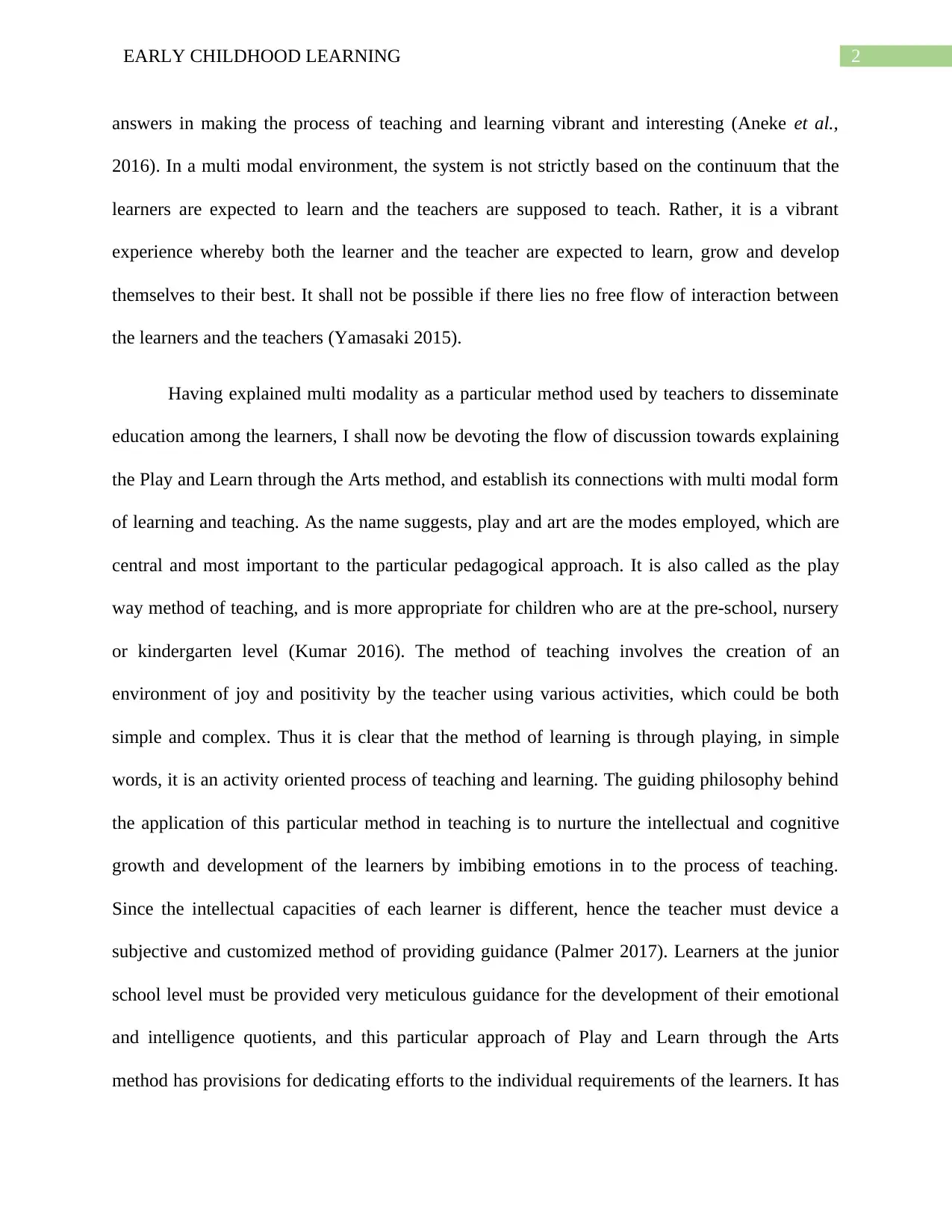
2EARLY CHILDHOOD LEARNING
answers in making the process of teaching and learning vibrant and interesting (Aneke et al.,
2016). In a multi modal environment, the system is not strictly based on the continuum that the
learners are expected to learn and the teachers are supposed to teach. Rather, it is a vibrant
experience whereby both the learner and the teacher are expected to learn, grow and develop
themselves to their best. It shall not be possible if there lies no free flow of interaction between
the learners and the teachers (Yamasaki 2015).
Having explained multi modality as a particular method used by teachers to disseminate
education among the learners, I shall now be devoting the flow of discussion towards explaining
the Play and Learn through the Arts method, and establish its connections with multi modal form
of learning and teaching. As the name suggests, play and art are the modes employed, which are
central and most important to the particular pedagogical approach. It is also called as the play
way method of teaching, and is more appropriate for children who are at the pre-school, nursery
or kindergarten level (Kumar 2016). The method of teaching involves the creation of an
environment of joy and positivity by the teacher using various activities, which could be both
simple and complex. Thus it is clear that the method of learning is through playing, in simple
words, it is an activity oriented process of teaching and learning. The guiding philosophy behind
the application of this particular method in teaching is to nurture the intellectual and cognitive
growth and development of the learners by imbibing emotions in to the process of teaching.
Since the intellectual capacities of each learner is different, hence the teacher must device a
subjective and customized method of providing guidance (Palmer 2017). Learners at the junior
school level must be provided very meticulous guidance for the development of their emotional
and intelligence quotients, and this particular approach of Play and Learn through the Arts
method has provisions for dedicating efforts to the individual requirements of the learners. It has
answers in making the process of teaching and learning vibrant and interesting (Aneke et al.,
2016). In a multi modal environment, the system is not strictly based on the continuum that the
learners are expected to learn and the teachers are supposed to teach. Rather, it is a vibrant
experience whereby both the learner and the teacher are expected to learn, grow and develop
themselves to their best. It shall not be possible if there lies no free flow of interaction between
the learners and the teachers (Yamasaki 2015).
Having explained multi modality as a particular method used by teachers to disseminate
education among the learners, I shall now be devoting the flow of discussion towards explaining
the Play and Learn through the Arts method, and establish its connections with multi modal form
of learning and teaching. As the name suggests, play and art are the modes employed, which are
central and most important to the particular pedagogical approach. It is also called as the play
way method of teaching, and is more appropriate for children who are at the pre-school, nursery
or kindergarten level (Kumar 2016). The method of teaching involves the creation of an
environment of joy and positivity by the teacher using various activities, which could be both
simple and complex. Thus it is clear that the method of learning is through playing, in simple
words, it is an activity oriented process of teaching and learning. The guiding philosophy behind
the application of this particular method in teaching is to nurture the intellectual and cognitive
growth and development of the learners by imbibing emotions in to the process of teaching.
Since the intellectual capacities of each learner is different, hence the teacher must device a
subjective and customized method of providing guidance (Palmer 2017). Learners at the junior
school level must be provided very meticulous guidance for the development of their emotional
and intelligence quotients, and this particular approach of Play and Learn through the Arts
method has provisions for dedicating efforts to the individual requirements of the learners. It has
⊘ This is a preview!⊘
Do you want full access?
Subscribe today to unlock all pages.

Trusted by 1+ million students worldwide
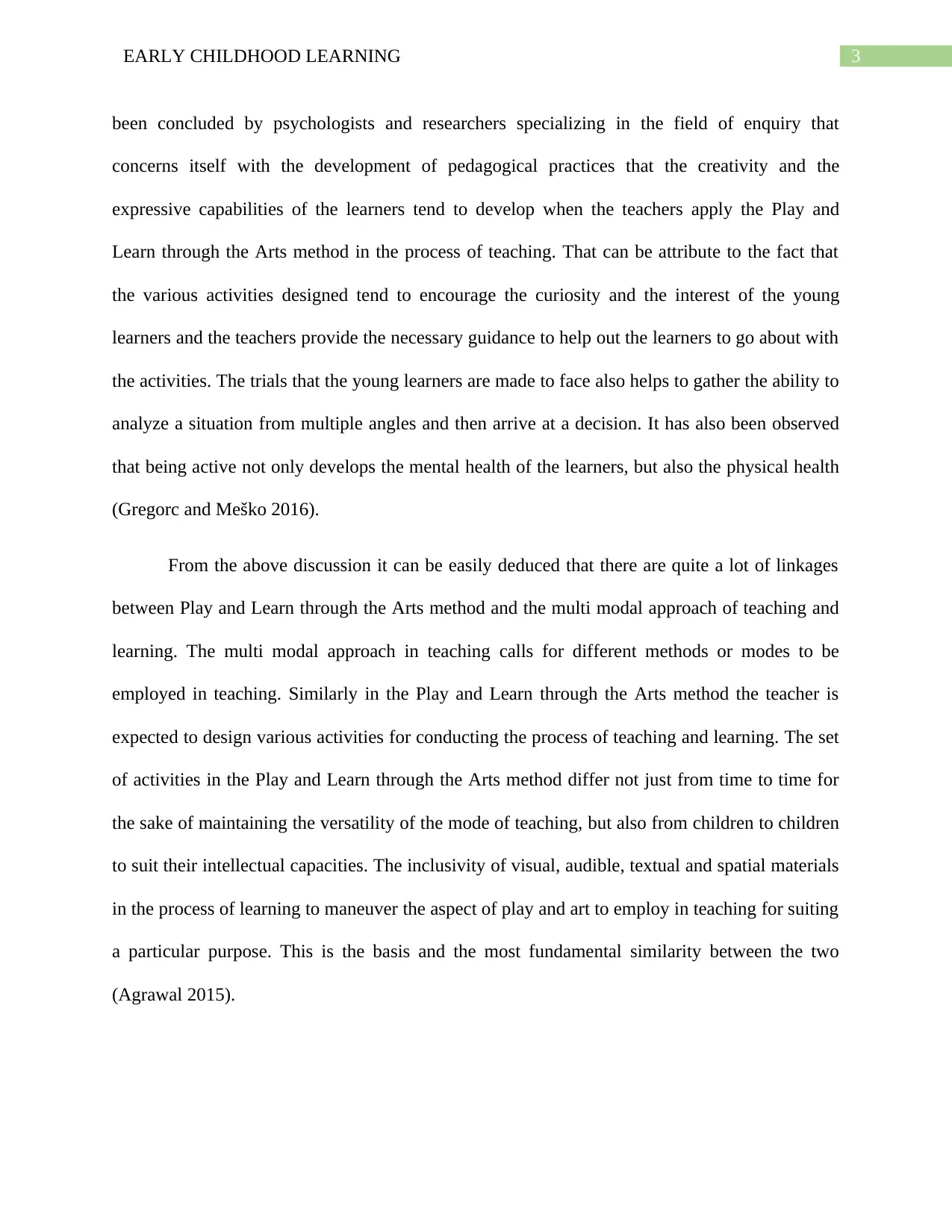
3EARLY CHILDHOOD LEARNING
been concluded by psychologists and researchers specializing in the field of enquiry that
concerns itself with the development of pedagogical practices that the creativity and the
expressive capabilities of the learners tend to develop when the teachers apply the Play and
Learn through the Arts method in the process of teaching. That can be attribute to the fact that
the various activities designed tend to encourage the curiosity and the interest of the young
learners and the teachers provide the necessary guidance to help out the learners to go about with
the activities. The trials that the young learners are made to face also helps to gather the ability to
analyze a situation from multiple angles and then arrive at a decision. It has also been observed
that being active not only develops the mental health of the learners, but also the physical health
(Gregorc and Meško 2016).
From the above discussion it can be easily deduced that there are quite a lot of linkages
between Play and Learn through the Arts method and the multi modal approach of teaching and
learning. The multi modal approach in teaching calls for different methods or modes to be
employed in teaching. Similarly in the Play and Learn through the Arts method the teacher is
expected to design various activities for conducting the process of teaching and learning. The set
of activities in the Play and Learn through the Arts method differ not just from time to time for
the sake of maintaining the versatility of the mode of teaching, but also from children to children
to suit their intellectual capacities. The inclusivity of visual, audible, textual and spatial materials
in the process of learning to maneuver the aspect of play and art to employ in teaching for suiting
a particular purpose. This is the basis and the most fundamental similarity between the two
(Agrawal 2015).
been concluded by psychologists and researchers specializing in the field of enquiry that
concerns itself with the development of pedagogical practices that the creativity and the
expressive capabilities of the learners tend to develop when the teachers apply the Play and
Learn through the Arts method in the process of teaching. That can be attribute to the fact that
the various activities designed tend to encourage the curiosity and the interest of the young
learners and the teachers provide the necessary guidance to help out the learners to go about with
the activities. The trials that the young learners are made to face also helps to gather the ability to
analyze a situation from multiple angles and then arrive at a decision. It has also been observed
that being active not only develops the mental health of the learners, but also the physical health
(Gregorc and Meško 2016).
From the above discussion it can be easily deduced that there are quite a lot of linkages
between Play and Learn through the Arts method and the multi modal approach of teaching and
learning. The multi modal approach in teaching calls for different methods or modes to be
employed in teaching. Similarly in the Play and Learn through the Arts method the teacher is
expected to design various activities for conducting the process of teaching and learning. The set
of activities in the Play and Learn through the Arts method differ not just from time to time for
the sake of maintaining the versatility of the mode of teaching, but also from children to children
to suit their intellectual capacities. The inclusivity of visual, audible, textual and spatial materials
in the process of learning to maneuver the aspect of play and art to employ in teaching for suiting
a particular purpose. This is the basis and the most fundamental similarity between the two
(Agrawal 2015).
Paraphrase This Document
Need a fresh take? Get an instant paraphrase of this document with our AI Paraphraser
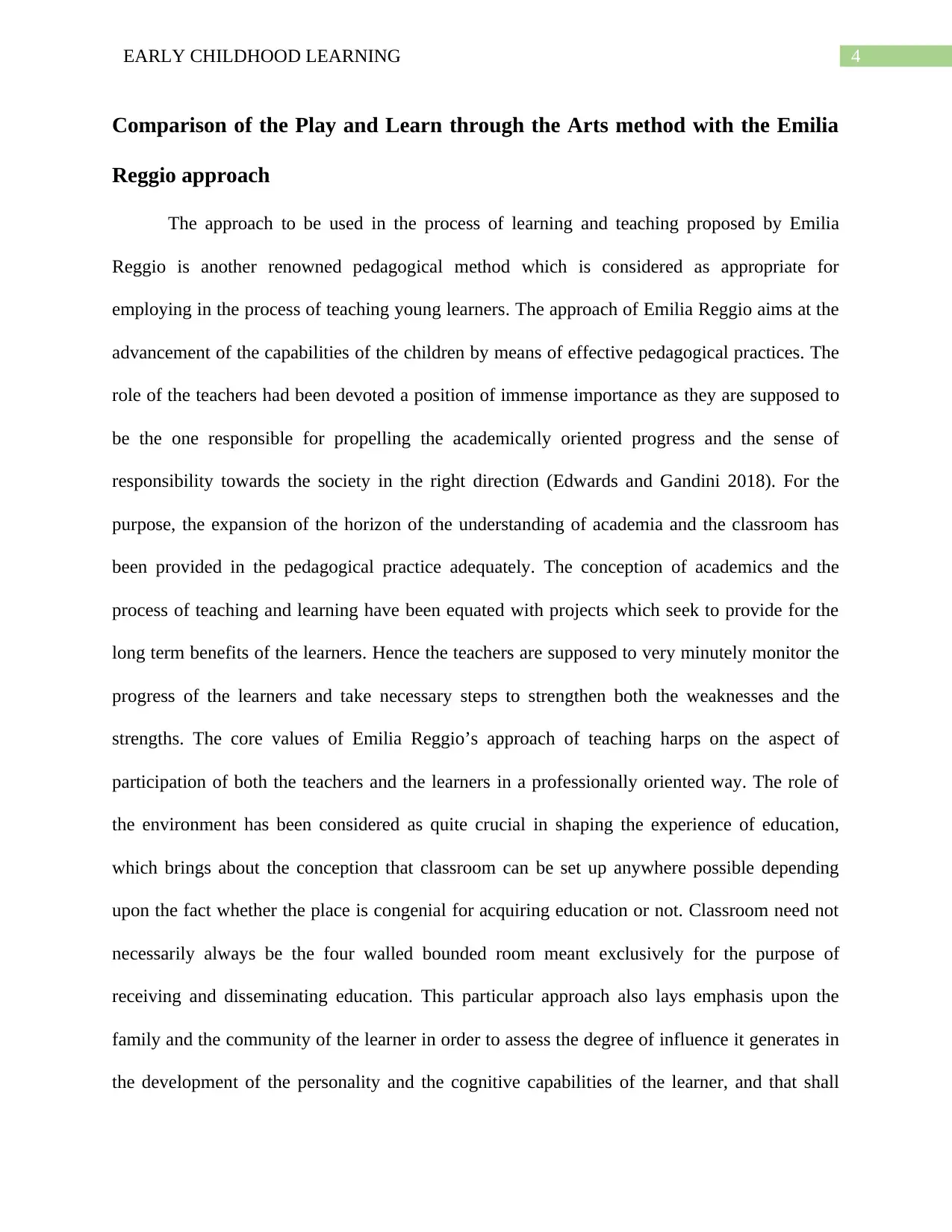
4EARLY CHILDHOOD LEARNING
Comparison of the Play and Learn through the Arts method with the Emilia
Reggio approach
The approach to be used in the process of learning and teaching proposed by Emilia
Reggio is another renowned pedagogical method which is considered as appropriate for
employing in the process of teaching young learners. The approach of Emilia Reggio aims at the
advancement of the capabilities of the children by means of effective pedagogical practices. The
role of the teachers had been devoted a position of immense importance as they are supposed to
be the one responsible for propelling the academically oriented progress and the sense of
responsibility towards the society in the right direction (Edwards and Gandini 2018). For the
purpose, the expansion of the horizon of the understanding of academia and the classroom has
been provided in the pedagogical practice adequately. The conception of academics and the
process of teaching and learning have been equated with projects which seek to provide for the
long term benefits of the learners. Hence the teachers are supposed to very minutely monitor the
progress of the learners and take necessary steps to strengthen both the weaknesses and the
strengths. The core values of Emilia Reggio’s approach of teaching harps on the aspect of
participation of both the teachers and the learners in a professionally oriented way. The role of
the environment has been considered as quite crucial in shaping the experience of education,
which brings about the conception that classroom can be set up anywhere possible depending
upon the fact whether the place is congenial for acquiring education or not. Classroom need not
necessarily always be the four walled bounded room meant exclusively for the purpose of
receiving and disseminating education. This particular approach also lays emphasis upon the
family and the community of the learner in order to assess the degree of influence it generates in
the development of the personality and the cognitive capabilities of the learner, and that shall
Comparison of the Play and Learn through the Arts method with the Emilia
Reggio approach
The approach to be used in the process of learning and teaching proposed by Emilia
Reggio is another renowned pedagogical method which is considered as appropriate for
employing in the process of teaching young learners. The approach of Emilia Reggio aims at the
advancement of the capabilities of the children by means of effective pedagogical practices. The
role of the teachers had been devoted a position of immense importance as they are supposed to
be the one responsible for propelling the academically oriented progress and the sense of
responsibility towards the society in the right direction (Edwards and Gandini 2018). For the
purpose, the expansion of the horizon of the understanding of academia and the classroom has
been provided in the pedagogical practice adequately. The conception of academics and the
process of teaching and learning have been equated with projects which seek to provide for the
long term benefits of the learners. Hence the teachers are supposed to very minutely monitor the
progress of the learners and take necessary steps to strengthen both the weaknesses and the
strengths. The core values of Emilia Reggio’s approach of teaching harps on the aspect of
participation of both the teachers and the learners in a professionally oriented way. The role of
the environment has been considered as quite crucial in shaping the experience of education,
which brings about the conception that classroom can be set up anywhere possible depending
upon the fact whether the place is congenial for acquiring education or not. Classroom need not
necessarily always be the four walled bounded room meant exclusively for the purpose of
receiving and disseminating education. This particular approach also lays emphasis upon the
family and the community of the learner in order to assess the degree of influence it generates in
the development of the personality and the cognitive capabilities of the learner, and that shall
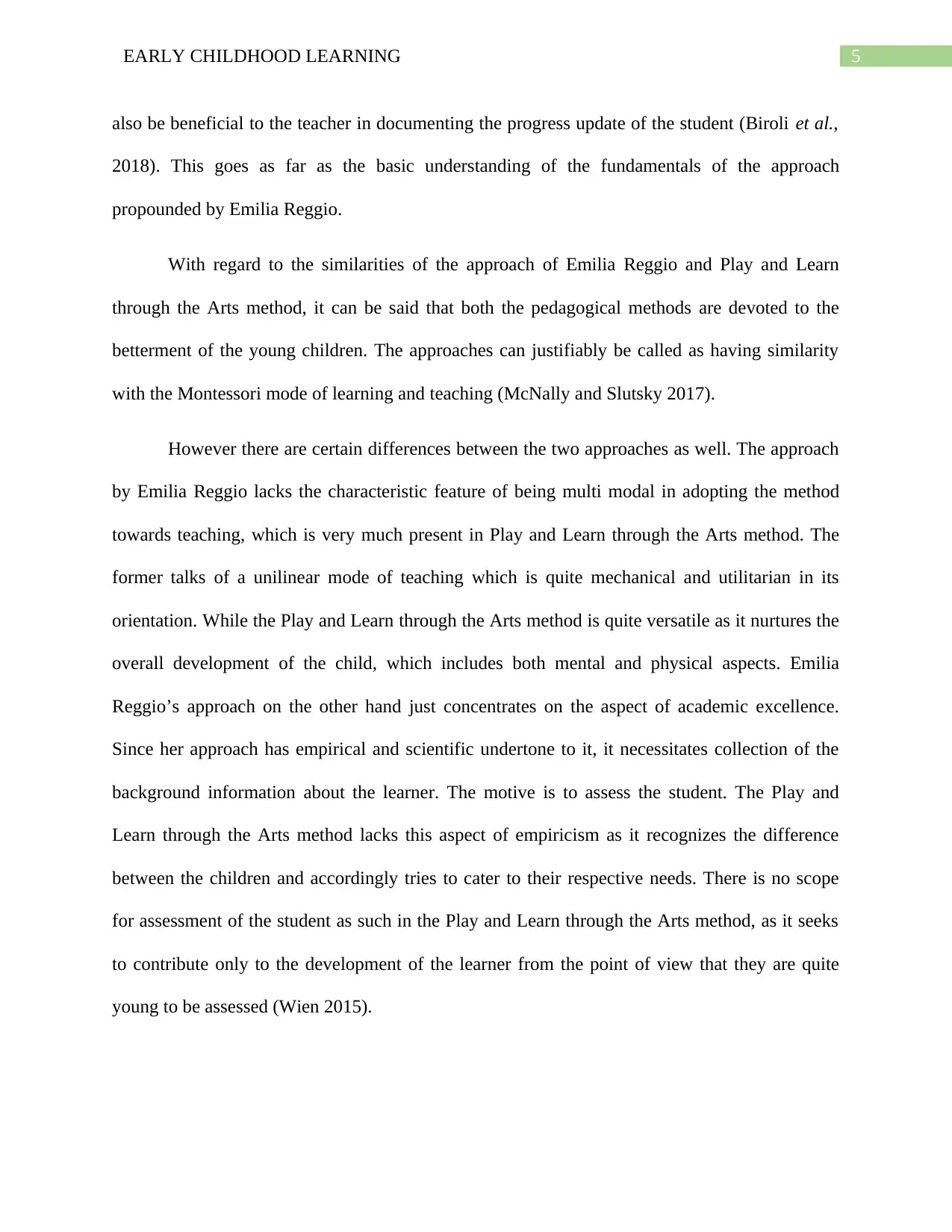
5EARLY CHILDHOOD LEARNING
also be beneficial to the teacher in documenting the progress update of the student (Biroli et al.,
2018). This goes as far as the basic understanding of the fundamentals of the approach
propounded by Emilia Reggio.
With regard to the similarities of the approach of Emilia Reggio and Play and Learn
through the Arts method, it can be said that both the pedagogical methods are devoted to the
betterment of the young children. The approaches can justifiably be called as having similarity
with the Montessori mode of learning and teaching (McNally and Slutsky 2017).
However there are certain differences between the two approaches as well. The approach
by Emilia Reggio lacks the characteristic feature of being multi modal in adopting the method
towards teaching, which is very much present in Play and Learn through the Arts method. The
former talks of a unilinear mode of teaching which is quite mechanical and utilitarian in its
orientation. While the Play and Learn through the Arts method is quite versatile as it nurtures the
overall development of the child, which includes both mental and physical aspects. Emilia
Reggio’s approach on the other hand just concentrates on the aspect of academic excellence.
Since her approach has empirical and scientific undertone to it, it necessitates collection of the
background information about the learner. The motive is to assess the student. The Play and
Learn through the Arts method lacks this aspect of empiricism as it recognizes the difference
between the children and accordingly tries to cater to their respective needs. There is no scope
for assessment of the student as such in the Play and Learn through the Arts method, as it seeks
to contribute only to the development of the learner from the point of view that they are quite
young to be assessed (Wien 2015).
also be beneficial to the teacher in documenting the progress update of the student (Biroli et al.,
2018). This goes as far as the basic understanding of the fundamentals of the approach
propounded by Emilia Reggio.
With regard to the similarities of the approach of Emilia Reggio and Play and Learn
through the Arts method, it can be said that both the pedagogical methods are devoted to the
betterment of the young children. The approaches can justifiably be called as having similarity
with the Montessori mode of learning and teaching (McNally and Slutsky 2017).
However there are certain differences between the two approaches as well. The approach
by Emilia Reggio lacks the characteristic feature of being multi modal in adopting the method
towards teaching, which is very much present in Play and Learn through the Arts method. The
former talks of a unilinear mode of teaching which is quite mechanical and utilitarian in its
orientation. While the Play and Learn through the Arts method is quite versatile as it nurtures the
overall development of the child, which includes both mental and physical aspects. Emilia
Reggio’s approach on the other hand just concentrates on the aspect of academic excellence.
Since her approach has empirical and scientific undertone to it, it necessitates collection of the
background information about the learner. The motive is to assess the student. The Play and
Learn through the Arts method lacks this aspect of empiricism as it recognizes the difference
between the children and accordingly tries to cater to their respective needs. There is no scope
for assessment of the student as such in the Play and Learn through the Arts method, as it seeks
to contribute only to the development of the learner from the point of view that they are quite
young to be assessed (Wien 2015).
⊘ This is a preview!⊘
Do you want full access?
Subscribe today to unlock all pages.

Trusted by 1+ million students worldwide
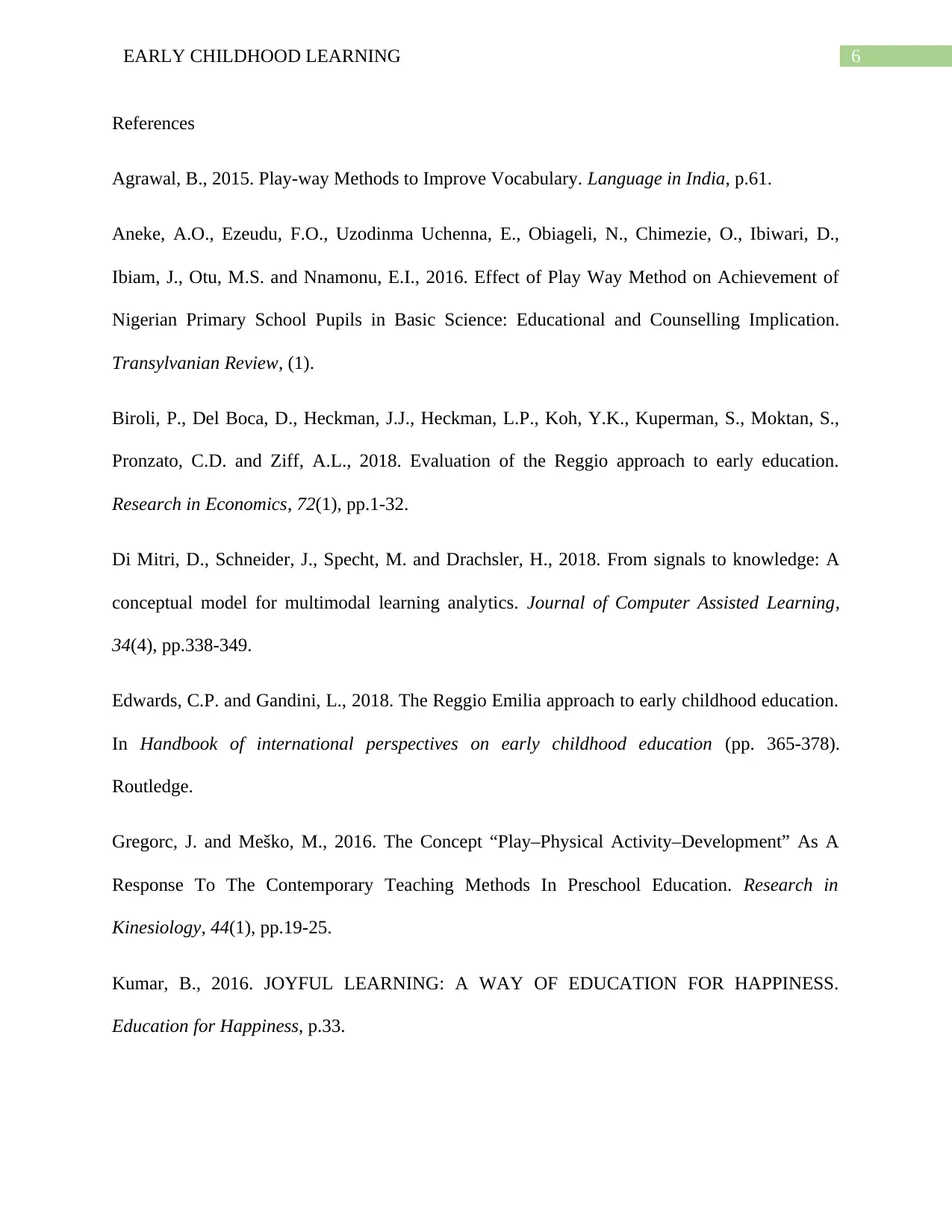
6EARLY CHILDHOOD LEARNING
References
Agrawal, B., 2015. Play-way Methods to Improve Vocabulary. Language in India, p.61.
Aneke, A.O., Ezeudu, F.O., Uzodinma Uchenna, E., Obiageli, N., Chimezie, O., Ibiwari, D.,
Ibiam, J., Otu, M.S. and Nnamonu, E.I., 2016. Effect of Play Way Method on Achievement of
Nigerian Primary School Pupils in Basic Science: Educational and Counselling Implication.
Transylvanian Review, (1).
Biroli, P., Del Boca, D., Heckman, J.J., Heckman, L.P., Koh, Y.K., Kuperman, S., Moktan, S.,
Pronzato, C.D. and Ziff, A.L., 2018. Evaluation of the Reggio approach to early education.
Research in Economics, 72(1), pp.1-32.
Di Mitri, D., Schneider, J., Specht, M. and Drachsler, H., 2018. From signals to knowledge: A
conceptual model for multimodal learning analytics. Journal of Computer Assisted Learning,
34(4), pp.338-349.
Edwards, C.P. and Gandini, L., 2018. The Reggio Emilia approach to early childhood education.
In Handbook of international perspectives on early childhood education (pp. 365-378).
Routledge.
Gregorc, J. and Meško, M., 2016. The Concept “Play–Physical Activity–Development” As A
Response To The Contemporary Teaching Methods In Preschool Education. Research in
Kinesiology, 44(1), pp.19-25.
Kumar, B., 2016. JOYFUL LEARNING: A WAY OF EDUCATION FOR HAPPINESS.
Education for Happiness, p.33.
References
Agrawal, B., 2015. Play-way Methods to Improve Vocabulary. Language in India, p.61.
Aneke, A.O., Ezeudu, F.O., Uzodinma Uchenna, E., Obiageli, N., Chimezie, O., Ibiwari, D.,
Ibiam, J., Otu, M.S. and Nnamonu, E.I., 2016. Effect of Play Way Method on Achievement of
Nigerian Primary School Pupils in Basic Science: Educational and Counselling Implication.
Transylvanian Review, (1).
Biroli, P., Del Boca, D., Heckman, J.J., Heckman, L.P., Koh, Y.K., Kuperman, S., Moktan, S.,
Pronzato, C.D. and Ziff, A.L., 2018. Evaluation of the Reggio approach to early education.
Research in Economics, 72(1), pp.1-32.
Di Mitri, D., Schneider, J., Specht, M. and Drachsler, H., 2018. From signals to knowledge: A
conceptual model for multimodal learning analytics. Journal of Computer Assisted Learning,
34(4), pp.338-349.
Edwards, C.P. and Gandini, L., 2018. The Reggio Emilia approach to early childhood education.
In Handbook of international perspectives on early childhood education (pp. 365-378).
Routledge.
Gregorc, J. and Meško, M., 2016. The Concept “Play–Physical Activity–Development” As A
Response To The Contemporary Teaching Methods In Preschool Education. Research in
Kinesiology, 44(1), pp.19-25.
Kumar, B., 2016. JOYFUL LEARNING: A WAY OF EDUCATION FOR HAPPINESS.
Education for Happiness, p.33.
Paraphrase This Document
Need a fresh take? Get an instant paraphrase of this document with our AI Paraphraser
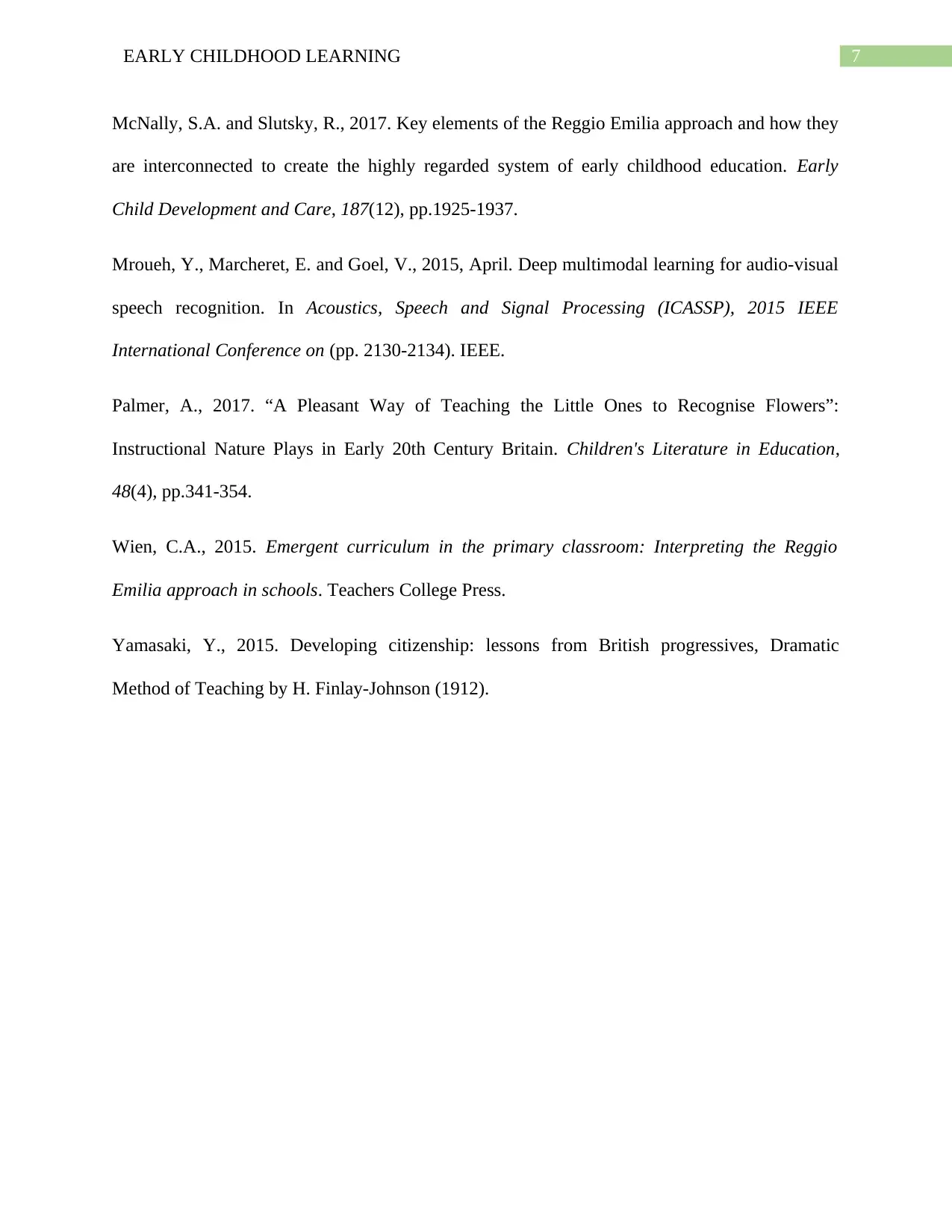
7EARLY CHILDHOOD LEARNING
McNally, S.A. and Slutsky, R., 2017. Key elements of the Reggio Emilia approach and how they
are interconnected to create the highly regarded system of early childhood education. Early
Child Development and Care, 187(12), pp.1925-1937.
Mroueh, Y., Marcheret, E. and Goel, V., 2015, April. Deep multimodal learning for audio-visual
speech recognition. In Acoustics, Speech and Signal Processing (ICASSP), 2015 IEEE
International Conference on (pp. 2130-2134). IEEE.
Palmer, A., 2017. “A Pleasant Way of Teaching the Little Ones to Recognise Flowers”:
Instructional Nature Plays in Early 20th Century Britain. Children's Literature in Education,
48(4), pp.341-354.
Wien, C.A., 2015. Emergent curriculum in the primary classroom: Interpreting the Reggio
Emilia approach in schools. Teachers College Press.
Yamasaki, Y., 2015. Developing citizenship: lessons from British progressives, Dramatic
Method of Teaching by H. Finlay-Johnson (1912).
McNally, S.A. and Slutsky, R., 2017. Key elements of the Reggio Emilia approach and how they
are interconnected to create the highly regarded system of early childhood education. Early
Child Development and Care, 187(12), pp.1925-1937.
Mroueh, Y., Marcheret, E. and Goel, V., 2015, April. Deep multimodal learning for audio-visual
speech recognition. In Acoustics, Speech and Signal Processing (ICASSP), 2015 IEEE
International Conference on (pp. 2130-2134). IEEE.
Palmer, A., 2017. “A Pleasant Way of Teaching the Little Ones to Recognise Flowers”:
Instructional Nature Plays in Early 20th Century Britain. Children's Literature in Education,
48(4), pp.341-354.
Wien, C.A., 2015. Emergent curriculum in the primary classroom: Interpreting the Reggio
Emilia approach in schools. Teachers College Press.
Yamasaki, Y., 2015. Developing citizenship: lessons from British progressives, Dramatic
Method of Teaching by H. Finlay-Johnson (1912).
1 out of 8
Your All-in-One AI-Powered Toolkit for Academic Success.
+13062052269
info@desklib.com
Available 24*7 on WhatsApp / Email
![[object Object]](/_next/static/media/star-bottom.7253800d.svg)
Unlock your academic potential
Copyright © 2020–2025 A2Z Services. All Rights Reserved. Developed and managed by ZUCOL.

